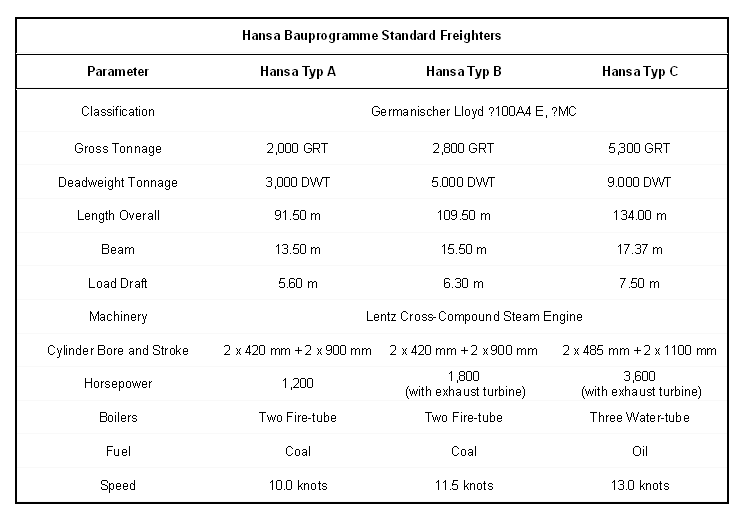The Brunsbüttel class fruit carrier was designed to meet the requirements of German shipping companies for a fast cargo ship capable of carrying perishable fruit cargos from the Caribbean, the Canary Islands and the Iberian Peninsula.
Displacement: 3,809 t light; 3,960 t standard; 7,536 t normal; 10,398 t full load
Dimensions: Length overall / water x beam x draught
374.49 ft / 367.45 ft x 49.87 ft x 21.33 ft (normal load) [114.14 m / 112.00 m x 15.20 m x 6.50 m]
Machinery:
Diesel Internal combustion motors, Geared drive, 2 shafts, 9,545 shp / 7,120 Kw = 18.00 kts
Range 21,780nm at 18.00 kts
Bunker at max displacement = 6,438 tons
Complement: 40 - 52
Cost: £1.042 million / $4.170 million
Distribution of weights at normal displacement:
Armament: 0 tons, 0.0 %
Machinery: 252 tons, 3.3 %
Hull, fittings & equipment: 1,757 tons, 23.3 %
Fuel, ammunition & stores: 3,727 tons, 49.5 %
Miscellaneous weights: 1,800 tons, 23.9 %
Overall survivability and seakeeping ability:
Survivability (Non-critical penetrating hits needed to sink ship): 2,081 lbs/944 kg = 19.3 x 6”/152mm shells or .4 torpedoes
Stability (Unstable if below 1.00): 1.10
Metacentric height 2.1 ft / 0.6 m
Roll period: 14.4 seconds
Steadiness - As gun platform (Average = 50 %): 86 %
- Recoil effect (Restricted arc if above 1.00): 0.00
Seaboat quality (Average = 1.00): 2.00
Hull form characteristics:
Hull has raised forecastle, rise forward of midbreak, raised quarterdeck
Block coefficient: 0.675
Length to Beam Ratio: 7.37: 1
'Natural speed' for length: 19.17 kts
Power going to wave formation at top speed: 48 %
Trim (Max stability = 0, Max steadiness = 100): 43
Bow angle (Positive = bow angles forward): 15.00 degrees
Stern overhang: 0.00 ft / 0.00 m
Freeboard (% = measuring location as a percentage of overall length):
- Stem: 26.25 ft / 8.00 m
- Forecastle (20 %): 24.93 ft / 7.60 m (16.73 ft / 5.10 m aft of break)
- Mid (50 %): 24.93 ft / 7.60 m (16.73 ft / 5.10 m aft of break)
- Quarterdeck (15 %): 24.93 ft / 7.60 m (16.73 ft / 5.10 m before break)
- Stern: 24.93 ft / 7.60 m
- Average freeboard: 20.94 ft / 6.38 m
Ship space, strength and comments:
Space - Hull below water (magazines/engines, low = better): 38.2 %
- Above water (accommodation/working, high = better): 126.4 %
Waterplane Area: 14,361 Square feet or 1,334 Square metres
Displacement factor (Displacement / loading): 327 %
Structure weight / hull surface area: 66 lbs/sq ft or 323 Kg/sq metre
Hull strength (Relative):
- Cross-sectional: 0.88
- Longitudinal: 3.34
- Overall: 1.00
Hull space for machinery, storage, compartmentation is excellent
Room for accommodation and workspaces is excellent
Ship has slow, easy roll, a good, steady gun platform
Excellent seaboat, comfortable, rides out heavy weather easily
Low-stowed cargo simmed as additional bunkers. Actual radius 8,000 nm.
Breakdown of miscellaneous weight:
120 tons for accommodations for up to twelve passengers
180 tons for derricks, winches and other cargo-handling gear
200 tons for refrigeration plant and associated systems
1,200 tons for high-stowed fruit cargo
Total cargo: 2,500 tons - of which 1,200 tons high stowed, 1,300 tons low stowed



















